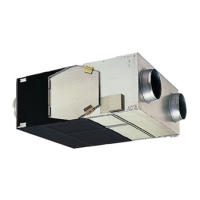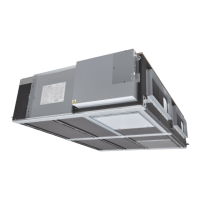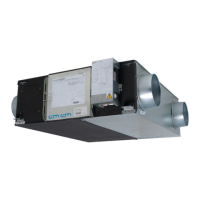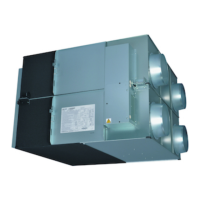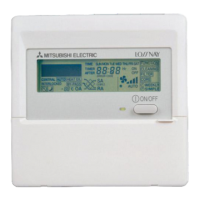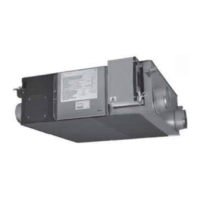
Do you have a question about the Mitsubishi Electric Lossnay LGH-100RX3-CAN and is the answer not in the manual?
| Brand | Mitsubishi Electric |
|---|---|
| Model | Lossnay LGH-100RX3-CAN |
| Category | Fan |
| Language | English |
Explains the fundamental reasons and purposes behind ventilation in buildings.
Details ventilation standards applicable in different countries.
Discusses various ventilation methods and their selection criteria.
Covers ventilation performance metrics like air volume and wind pressure.
Explains how to calculate the load imposed by outdoor air intake.
Details the construction and key features of the Lossnay unit.
Explains the design and working principle of the Lossnay Core.
Provides formulas and methods for calculating heat recovery efficiency.
Defines and explains the use of a psychrometric chart for air properties.
Details the calculation methods for Lossnay heat recovery.
Compares Lossnay's heat recovery effect with other ventilation methods.
Provides practical examples of heat recovery calculations.
Details the economical benefits and cost calculations of using Lossnay.
Presents a psychrometric chart for calculating Lossnay economical effects.
Reports test results on Lossnay Core's resistance to bacteria and molds.
Details the flame-proofing properties of the Lossnay Core material.
Presents test results on the soundproofing properties of the Lossnay Core.
Analyzes the changes in Lossnay units over time through a case study.
Compares different methods of heat recovery techniques.
Explains how to interpret characteristic curves for performance evaluation.
Details the calculation of static pressure loss in ductwork.
Describes methods to obtain efficiency using characteristic curves.
Covers sound characteristics, measurement, and analysis.
Presents Noise Criteria (NC) curves for different models.
Lists model specifications and available accessories.
Outlines conditions for using Lossnay, including cold and high humidity environments.
Provides information on the noise levels of Lossnay units with fans.
Details the importance and attachment of air filters.
Offers recommendations for duct construction to prevent issues.
Advises against operating with by-pass ventilation during heating.
Details gas transmission rates and maximum workplace concentrations.
Discusses the effect of water-soluble gases and mists on the Lossnay Core.
Explains the automatic ventilation mode for optimizing performance.
Covers installation methods, including vertical and reverse installations.
Provides guidance on installing supplementary fan devices.
Presents a system plan for a large office building application.
Details a system plan for a medium-sized office building.
Describes a system plan for urban small-scale buildings.
Outlines ventilation system plans for hospitals.
Presents ventilation system plans for schools.
Details system plans for public halls and combination facilities.
Illustrates installation diagrams for different Lossnay models.
Guides on selecting duct attachment directions for optimal installation.
Covers essential installation and maintenance considerations.
Details various installation applications and configurations.
Provides instructions for connecting wiring and mounting remote controllers.
Explains the procedure for mounting the protective cover.
Details how to switch function selection settings using DIP switches.
Covers external switching of High/Low fan speed using sensors.
Explains connections with City Multi, M-NET, and MELANS systems.
Provides precautions for installing M-NET transmission cables.
Details system designs and address definitions for M-NET.
Explains the importance of filters for clean air and health.
Provides data on dust concentrations and filter applicability.
Presents dust collection efficiency data for various Lossnay filters.
Compares different methods used for measuring dust collection efficiency.
Details the calculation of dust concentration in air conditioning systems.
Discusses the service life and durability of the Lossnay Core.
Provides instructions for cleaning the Lossnay Core and pre-filter.
Details ventilation standards for Japan, the U.S., and the U.K.
Provides a summary of the technical manual for Lossnay remote controllers.
Lists applicable Lossnay models and remote controllers.
Defines key terms related to Lossnay operation and systems.
Details system features and provides examples of configurations.
Explains applications using external control input and output terminals.
Provides detailed instructions for connecting cables for PZ-41SLB-E and M-NET.
Explains how to change fan speed externally using sensors.
Details remote/local control change and ON/OFF input for M-NET.
Outlines the service flow for diagnosing and resolving issues.
Provides checklist for troubleshooting system startup failures.
Checklist for remote controller operation issues.
Troubleshooting steps for irregular remote controller operation.
Checklist for Lossnay unit operation irregularities.
Lists error codes and their corresponding cancellation measures.
Details electrical installation procedures and component identification.
Provides instructions for connecting the power supply and transmission cables.
Explains how to set various functions using DIP switches and rotary switches.
Guides on performing trial operations for the system.
Describes the operation of the PZ-41SLB-E remote controller.
Explains different modes of operation for the remote controller.
Provides guidance on care and upkeep of the remote controller.
Information regarding after-sales service for the remote controller.
Details the components and external dimensions of the remote controller.
Provides installation dimensions for the remote controller.
Describes the operation of the PZ-52SF-E M-NET remote controller.
Provides instructions for installing the M-NET remote controller.
Details the process of registering Lossnay units with the M-NET remote controller.
Covers operation settings, initial settings, group configuration, and interlocked operation.
Explains the operation of Lossnay with Mr. Slim indoor units using A-control.
Details operation and registration for Network Remote Controller.

